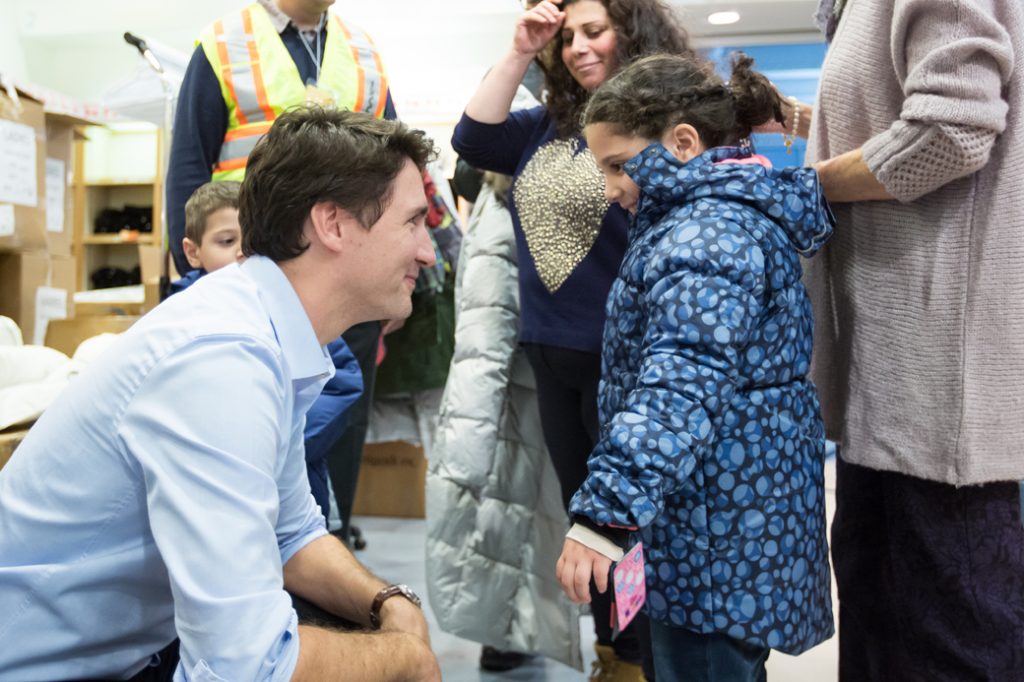

Features
Immigration
Ottawa boosting immigration to record levels as it battles ‘critical’ labour shortage
November 1, 2022
By
Talent Canada
 Prime Minister Justin Trudeau welcomes Syrian refugees to Canada at the Toronto Pearson International Airport in December 2015. Photo: Adam Scotti (PMO)
Prime Minister Justin Trudeau welcomes Syrian refugees to Canada at the Toronto Pearson International Airport in December 2015. Photo: Adam Scotti (PMO) The federal government is rolling out an aggressive plan to boost immigration to record levels, targeting 500,000 newcomers annually by 2025.
The move is in response to critical labour shortages, Ottawa said, which are causing uncertainty for Canadian businesses and workers.
Sean Fraser, Minister of Immigration, Refugees and Citizenship, released Canada’s 2023–2025 Immigration Levels Plan.
“Last year, we welcomed the most newcomers in a single year in our history,” said Fraser. “This year’s immigration levels plan will help businesses find the workers they need, set Canada on a path that will contribute to our long-term success, and allow us to make good on key commitments to vulnerable people fleeing violence, war and persecution.”
The plan embraces immigration as a strategy to help businesses find workers and to attract the skills required in key sectors — including health care, skilled trades, manufacturing and technology — to manage the social and economic challenges Canada will face in the decades ahead, the government said.
2021 was a record year
Last year, more than 405,000 people immigrated to Canada – the most ever. Ottawa wants to build on that number with targets of 465,000 in 2023; 485,000 in 2024; and 500,000 in 2025.
Ottawa is also attempting to ensure immigrants settle in different regions of the country, including small towns and rural communities.
Plan highlights
Slightly more than 60 per cent of immigrants will come under the economic class by 2025, it said.
It also wants to use new features in the Express Entry system to target people with skills and qualifications in sectors facing labour challenges, including health care, manufacturing, building trades and STEM (science, technology, engineering and math).
Ottawa said it will increase regional programs to target local needs through the Provincial Nominee Program, the Atlantic Immigration Program and the Rural and Norther Immigration Pilot.
It also said it plans to reunite families faster and ensure that at least 4.4 per cent of new permanent residents outside of Quebec are francophone.
It also plans to provide a safe haven for people facing persecution by expanding the Economic Mobility Pathways Pilot.
Top destination for talent
This plan helps cement Canada’s place among the world’s top destinations for talent, the government said, creating a strong foundation for continued economic growth, while also reuniting family members with their loved ones and fulfilling Canada’s humanitarian commitments.
Sean Strickland, the executive director of Canada’s Building Trades Union (CBTU) said his organization was pleased with the announcement.
“Historically it has been through immigration that we have been able to grow our workforce, fill our union halls and build Canada’s infrastructure,” he said. “Increased economic immigration is an important step to addressing labour availability across the country and we look forward to continuing to work closely with Minister Fraser and the federal government to find the solutions we need going forward.”
Quick facts
- The federal government said immigration accounts for nearly 100 per cent of Canada’s labour force growth. By 2032, it is projected to account for 100 per cent of the country’s population growth.
- Canada’s aging population means that the worker-to-retiree ratio is expected to shift from 7 to 1 50 years ago to 2 to 1 by 2035.
- During the 2021 Census, nearly 1 in 4 people counted were or had been a landed immigrant or permanent resident in Canada, the highest proportion since Confederation and the largest proportion among G7 countries.
- Just over 1.3 million new immigrants settled permanently in Canada from 2016 to 2021, the highest number of recent immigrants recorded in a Canadian census.
- The levels plan takes into account extensive engagement with provincial and territorial representatives, as well as public opinion research and stakeholder consultations.
- The Action Plan for Official Languages – 2018-2023: Investing in Our Future provided nearly $500 million over five years in support of official languages, including $40.8 million for Francophone immigration initiatives.
- Canadians across the country can see how newcomers are benefiting local communities through Immigration, Refugees and Citizenship Canada’s Immigration Matters campaign.
- Under the Canada-Quebec Accord, Quebec establishes its own immigration levels.
Print this page